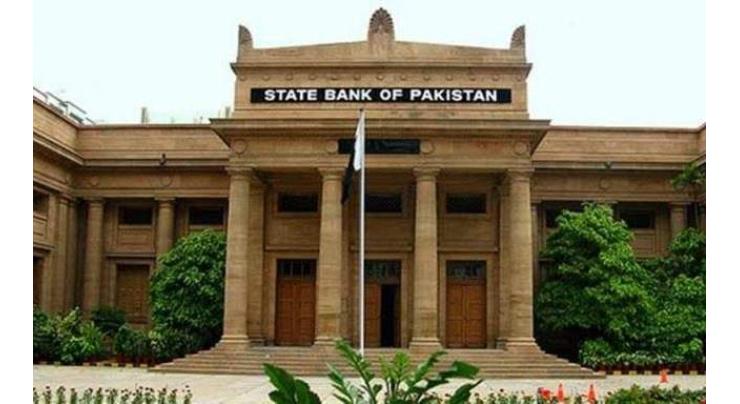
State Bank Of Pakistan Increases Policy Rate By 100bps To 13.25%
Fahad Shabbir (@FahadShabbir) Published July 17, 2019 | 01:22 AM

The State Bank of Pakistan (SBP) on Tuesday announced to increase its policy (interest) rate by 100 basic points (1%) to 13.25 percent; effective from July 17, 2019
SBP's Monetary Policy Committee, in its meeting here on July 16, took this decision taking into account upside inflationary pressures from exchange rate depreciation since the last MPC meeting on May 20,2019 and the likely increase in near term inflation from the one-off impact of recent adjustments in utility prices and other measures in the federal annual budget for the year 2019-20, said SBP Governor, Dr. Reza Baqir at a press conference on the bi-monthly monetary policy statement.
He said the MPC decision also took into account downside inflation pressures from softening demand indicators. Taking these factors into consideration, the MPC expected average inflation of 11 to 12 percent in FY20, higher than previously projected. Nevertheless, inflation is expected to fall considerably in FY21 as the one-off effect of some of the causes of the recent rise in inflation diminishes.
With this decision on interest rates, the MPC was of the view that the adjustment related to interest rates and the exchange rate from previously accumulated imbalances had taken place. Going forward the MPC would be ready to take action depending on economic developments and data out turns.
Unanticipated increases in inflation that adversely affect the inflation outlook might lead to further modest tightening. On the other hand, a greater than expected softening in domestic demand and downward revision in projected inflation would provide grounds for easing monetary conditions.
In reaching this decision, he said, the MPC considered the key economic developments since the last MPC meeting on May 20, 2019-- developments in the real, external and fiscal sectors, and the resulting outlook for monetary conditions and inflation.
Highlighting the key developments since the last MPC, the Governor said that there had been three key developments since the last MPC meeting.
First, the Government of Pakistan had passed a FY20 budget that sought to credibly improve fiscal sustainability by focusing on revenue measures to widen the tax base. Adjustments in utility prices and other measures in the budget were expected to lead to a one-time considerable increase in prices in the first half of FY20. On the other hand, he continued, the government had also committed to cease borrowing from the State Bank that would qualitatively improve the inflation outlook.
Secondly, the outlook for external financing has further strengthened with the disbursement of the first tranche associated with the International Monetary Fund's Extended Fund Facility, activation of the Saudi oil facility, and other commitments of support from multilateral and bilateral partners. The current account deficit had also continued to fall suggesting that external pressures continue to decline.
On the other hand, he said, the depreciation in the exchange rate since the last MPC had added to inflationary pressures. Finally, on the international front, the sentiment towards emerging markets has improved with greater expectations of a policy rate cut in the United States.
About the real sector, SBP Chief said the domestic demand was estimated to moderate to about three percent in FY19 and Gross Domestic Product (GDP) growth to 3.3 percent. While current high frequency indicators point to a slowing in economic activity, this was expected to turn around in the course of the year on the back of improved market sentiments in the context of IMF supported program, a rebound in the agriculture sector and the gradual impact of government incentives for export-oriented industries. Conditional upon the latest available information, SBP expect the real GDP growth of around 3.5 percent in FY20.
Dr. Reza Baqir , referring to the external sector, said the eternal conditions showed continued steady improvement with a sizeable reduction in the current account deficit which fell by 29.3 percent to dollars 12.
7 billion in the period of July 2018 to May 2019 as compared to $ 17.9 billion during the same period last year.
This improvement was primarily driven by import compression and healthy growth in workers' remittances. Export volumes had been growing even though export values had remained subdued due to a fall in unit prices as also experienced by competitor exporting countries. Future developments in export performance would also depend on growth rates of our trading partners and progress in alleviating domestic structural impediments.
SBP's foreign exchange reserves had risen to about dollars 8 billion on July 12, 2019 with the disbursement of the first tranche of the IMF's Extended Fund Facility. Reserves were expected to rise further in FY20 on account of additional financial inflows from other international creditors including those related to the Saudi oil facility and continued improvement in current account deficit.
The bulk of the needed adjustment in the real effective exchange rate to address the past overhang of overvaluation had been completed with the recent deprecation of the exchange rate. While the exchange rate was flexible and market determined the SBP stood ready to take action to address disorderly market conditions in the foreign exchange market.
About fiscal sector, the Governor said that led by substantial shortfall in revenue collection, higher than budgeted interest payments and security related expenditures, both the overall fiscal and primary deficits deteriorated in FY19. The FY20 budget sought to credibly reverse the recent trend of fiscal deterioration by addressing long-standing weaknesses in the taxation system and to enhance documentation of economic activities. On the back of an ambitious target for tax collection and tight control over expenditures, the budget envisaged a sizable reduction in primary deficit. This fiscal consolidation would support SBP's stabilization policies already in place.
From a monetary policy perspective, the government's strong commitment to end its borrowing from the SBP, and the implementation of liability management operation to restructure the outstanding debt held by SBP would positively contribute towards monetary policy transmission while credibly anchor markets' inflation expectations going forward.
SBP Governor, speaking on the monetary and inflation outlook, said the reflecting the impact of stabilization measures, private sector credit (PSC) growth had started to decelerate. PSC expanded 11.4 percent during July 1, 2018 to June 28, 2019 as compared to 14.8 percent during the same period last year. The deceleration in credit was more pronounced in real terms as the increase in PSC was largely driven by higher input prices, which in turn increased the working capital needed of the businesses. This, together with higher budgetary borrowing led to a sharp increase in the net domestic assets (NDA) of the banking system. In aggregate, broad money supply (M2) grew by 12.2 percent during July 1, 2018 to June 28, 2019 as compared to 10 percent during the comparable period last year. Going forward, the composition of money supply was expected to change as net foreign assets (NFA) of the banking system is projected to improve, while the growth in NDA was likely to show substantial moderation.
Dr. Reza Baqir said that inflation rose considerably to 7.3 percent in FY19 due to higher government borrowing from SBP, lagged impact of exchange rate depreciations, hike in domestic fuel prices, and rising food prices. Consumer Price Index (CPI) inflation was 8.9 percent in June 2019 and was expected to rise in the near term due to the one-off impact of adjustment in utilities prices and other measures in the FY 2020 budget. These pressures were expected to recede in the second half of the fiscal year and the MPC expects inflation to average 11 to 12 percent in FY20.
The MPC is of the view that real interest rates implied by these inflation projections and today's policy rate decision are at appropriate levels considering the cyclical weakening of aggregate demand, he said.
Related Topics
Recent Stories

Punjab CM inaugurates Pakistan’s first Virtual Women Police Station

Dutch model Donny Roelvink embraces Islam

Experts raise concerns over introduction of 10-stick packs

Iranian president arrives in Karachi

Law Minister expresses Govt's resolve to address issue of missing persons

Rizwan’s batting order may be changed: Sources

Nawaz Sharif to visit Guangzhou exhibition in China

FM Dar not traveling to China: Foreign Office

PM takes notice of deliberate delay in tax cases

Iranian President visits Allama Iqbal’s mausoleum

Iranian President arrives in Lahore today

Currency Rate In Pakistan - Dollar, Euro, Pound, Riyal Rates On 23 April 2024
More Stories From Business
-
Afghan trade delegation, FPCCI discuss bilateral trade
4 hours ago -
With knowledge economy, Mauritius is a stable economy: Envoy
5 hours ago -
Aurangzeb reiterates govt's resole to reduce poverty, promote sustainable development
6 hours ago -
Finance minister meets Chairman Anjuman-e-Tajran; discuss issues of business community
6 hours ago -
Govt ensuring digital access as fundamental right: Ahsan Iqbal
6 hours ago -
WHO delegation calls on Chairman FBR
6 hours ago
-
Bill drafted to regulate veterinary sciences and animal welfare: Tanveer
7 hours ago -
General Motors lifts 2024 profit forecast after strong Q1
7 hours ago -
Pakistan aims to reach $3 trillion economy by 2047: Ahsan Iqbal
8 hours ago -
Digital technologies play significant role in economic growth: Shaza
8 hours ago -

Experts raise concerns over introduction of 10-stick packs
8 hours ago -
SACM directs making technical institutes as skill imparting centres
9 hours ago






